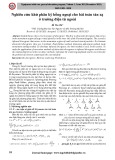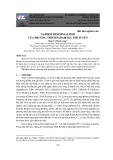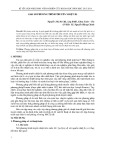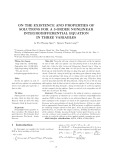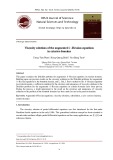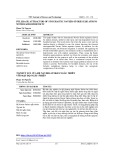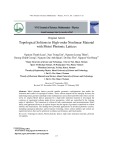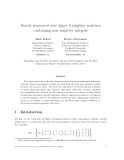HPU2. Nat. Sci. Tech. Vol 03, issue 02 (2024), 87-92.
HPU2 Journal of Sciences: Natural Sciences and Technology
Journal homepage: https://sj.hpu2.edu.vn
Article type: Research article
A non-existence result for higher-order Hardy-Hénon inequality on punctured balls
Thi-Ngoan Trana,b, Van-Tuan Tranb*
aThai Binh University, Thai Binh, Vietnam bHanoi Pedagogical University 2, Vinh Phuc, Vietnam
Abstract
Let 𝑛 and 𝑚 be two positive integers such that 𝑛 > 2𝑚 ≥ 4. Let 𝜎 and 𝑝 be real such that 𝜎 < −2𝑚 and 𝑝 > 1. In this note, we are mainly concerned with non-negative and classical solutions of the high-order harmonic inequality
(−Δ)(cid:3040)𝑢 ≥ |𝑥|(cid:3097)𝑢(cid:3043), on the punctured ball 𝑩𝑹 ∖ {𝟎} ⊂ 𝐑𝒏. Using the method of test functions, the Hölder's inequality, and integral estimates, we will prove that this inequality has no 𝑪𝟐𝒎 positive solution satisfying some sufficient conditions. It should be mentioned that our result, see Theorem 1.1 in the next section, in the high-order setting is analogous to that of Laptev for the case 𝒎 = 𝟐.
Keywords: Hardy–Hénon polyharmonic equation, non–negative and classical solution, existence and non–existence, weak and strong super–polyharmonic properties
(cid:2870) + ⋯ + 𝑥(cid:3041)
1. Introduction
Let 𝑛 and 𝑚 be two integers such that 𝑛 > 2𝑚 ≥ 4. Let 𝜎 and 𝑝 be real such that 𝜎 < −2𝑚 and 𝑝 > 1. In 𝐑(cid:3041), we use the notation |𝑥| as the standard norm of a vector 𝑥 = (𝑥(cid:2869), … , 𝑥(cid:3041)) in 𝐑(cid:3041), i.e. (cid:2870)) (cid:2869)/(cid:2870) and 𝐵(cid:3019) is the ball of radius 𝑅, centered at the origin. We also write Δ as the |𝑥| = (𝑥(cid:2869)
(cid:3118) + ⋯ +
(cid:3105)(cid:3118) (cid:3118). (cid:3105)(cid:3051)(cid:3289)
(cid:3105)(cid:3118) (cid:3105)(cid:3051)(cid:3117)
Laplace operator: Δ =
We are concerned with non-negative, non-trivial and classical solutions to the following functional inequality involving the high-order Laplace operator:
* Corresponding author, E-mail: tranvantuan@hpu2.edu.vn
https://doi.org/10.56764/hpu2.jos.2024.3.2.87-92
Received date: 28-3-2024 ; Revised date: 29-6-2024 ; Accepted date: 30-7-2024
This is licensed under the CC BY-NC 4.0
87
(1) (−Δ)(cid:3040)𝑢(𝑥) ≥ |𝑥|(cid:3097)𝑢(cid:3043)(𝑥) in 𝐵(cid:3019) ∖ {0} ⊂ 𝐑(cid:3041).
HPU2. Nat. Sci. Tech. 2024, 3(2), 87-92
The reason why we are interested in solutions to (1) goes back to a striking result due to Laptev, see Theorem 2 in [1]. This result says that the inequality (1) holds for 𝑚 = 2, i.e. if 𝑛 ≥ 5, 𝑝 > 1, and 𝜎 ≤ −4, the functional inequality
(−Δ)(cid:2870)𝑢(𝑥) ≥ |𝑥|(cid:3097)𝑢(cid:3043)(𝑥) in 𝐵(cid:3019) ∖ {0} ⊂ 𝐑(cid:3041),
admits no punctured solution 𝑢 satisfying
Δ𝑢𝑑𝜎 ≤ 0. (2) (cid:3505) (cid:2986)(cid:3003)(cid:3267)
See also Section 6 in [2]. To obtain the above result, Laptev used the method of test functions, which depends heavily on the conditions 𝑛 ≥ 5 and 𝜎 ≤ −4.
Of interest in this paper is to extend Laptev's result to a higher order setting. The main result is as follows.
Theorem 1.1. Let 𝑛 > 2𝑚 and 𝑅 > 0. Then the problem
(−Δ)(cid:3040)𝑢 ≥ |𝑥|(cid:3097)𝑢(cid:3043) in 𝐵(cid:3019) ∖ {0} ⊂ 𝐑(cid:3041),
with 𝑝 > 1 and 𝜎 < −2𝑚 does not admit any non-negative, non-trivial punctured solution 𝑢 satisfying:
(−Δ)(cid:3038)𝑢𝑑𝜎 ≥ 0, (3) (cid:3505) (cid:2986)(cid:3003)(cid:3267)
for all 1 ≤ 𝑘 ≤ 𝑚 − 1.
It should be noted that without assuming the boundary conditions (3), Theorem 1.1 is in general not true. This was already discussed in [3] in the case 𝑚 = 2. For some other related results, the reader can consult in the recent works [1], [4]–[20].
To prove Theorem 1.1, we first recall a preliminary result in Section 2. Second, the proof of Theorem 1.1 will be shown in Section 3.
2. A technical result
The following lemma is the initial step of showing Theorem 1.1. Lemma 2.1. There exists a function Φ ∈ 𝐶(cid:2870)(cid:3040)(𝐵(cid:2869) ∖ {0}) satisfying Φ > 0 in 𝐵(cid:2869) ∖ {0},
(−Δ)(cid:3040)Φ = 0 in 𝐵(cid:2869) ∖ {0},
and for all 0 ≤ 𝑖 ≤ 𝑚 − 1,
(cid:2986) (cid:2986)(cid:3049)
(−Δ)(cid:3036)Φ(𝑥) = 0 in 𝐵(cid:2869) ∖ {0} and (−Δ)(cid:3036)Φ(𝑥) ≤ 0 on ∂𝐵(cid:2869).
Proof. For clarity, we denote by Φ(cid:3040) the desired function. Let us construct by induction on 𝑚 that
(cid:3040)(cid:2879)(cid:2869) Φ(cid:3040)(𝑥) = 𝛽(cid:3040)|𝑥|(cid:2870)(cid:3040)(cid:2879)(cid:3041) + (cid:3533) (cid:3036)(cid:2880)(cid:2868)
(4) 𝛽(cid:3036)|𝑥|(cid:2870)(cid:3036) in 𝐵(cid:2869) ∖ {0},
for some appropriate constant 𝛽(cid:3040) > 0 and 𝛽(cid:3036) ∈ 𝐑.
88
https://sj.hpu2.edu.vn
For 𝑚 = 1, the function Φ(cid:2869) is given as follows 1 Φ(cid:2869)(𝑥) = 𝑐(cid:2869) (cid:3436) |𝑥|(cid:3041)(cid:2879)(cid:2870) − 1(cid:3440),
HPU2. Nat. Sci. Tech. 2024, 3(2), 87-92
where 𝑐(cid:2869) > 0 is a constant chosen in such a way that 𝑐(cid:2869)/|𝑥|(cid:3041)(cid:2879)(cid:2870) is the fundamental solution to the Laplace equation in 𝐑(cid:3041) with 𝑛 > 2. Suppose that Φ(cid:3040) is given by (4), we now construct Φ(cid:3040)(cid:2878)(cid:2869) as follows.
Let constants 𝛾(cid:3036)(0 ≤ 𝑖 ≤ 𝑚 + 1) be given as follows
> 0, 𝛽(cid:3040) 2𝑚(𝑛 − 2𝑚) ⎧𝛾(cid:3040)(cid:2878)(cid:2869) = ⎪ ⎪ for 0 ≤ 𝑖 ≤ 𝑚, 𝛾(cid:3036) = 𝛽(cid:3036) 2𝑖(2𝑖 + 𝑛 − 2)
(cid:3040)(cid:2878)(cid:2869) 𝛾(cid:2868) = − (cid:3533) (cid:3036)(cid:2880)(cid:2869)
𝛾(cid:3036). ⎨ ⎪ ⎪ ⎩
We define
(cid:3040) Φ(cid:3040)(cid:2878)(cid:2869)(𝑥) = 𝛾(cid:3040)(cid:2878)(cid:2869)|𝑥|(cid:2870)(cid:3040)(cid:2878)(cid:2870)(cid:2879)(cid:3041) + (cid:3533) (cid:3036)(cid:2880)(cid:2868)
𝛾(cid:3036)|𝑥|(cid:2870)(cid:3036).
For the positivity of Φ(cid:3040)(cid:2878)(cid:2869), it can be seen that for any 𝑥 ∈ 𝐵(cid:2869) ∖ {0},
(cid:3040) Φ(cid:3040)(cid:2878)(cid:2869)(𝑥) > 𝛾(cid:3040)(cid:2878)(cid:2869) + 𝛾(cid:2868) + (cid:3533) (cid:3036)(cid:2880)(cid:2869)
max(𝛾(cid:3036), 0) ≥ 0.
We now prove that (−Δ)(cid:3040)(cid:2878)(cid:2869)Φ(cid:3040)(cid:2878)(cid:2869) = 0 in 𝐵(cid:2869) ∖ {0}. Indeed, using the following computations for any 𝑎,
(5) ∇|𝑥|(cid:3028) = 𝑎𝑥|𝑥|(cid:3028)(cid:2879)(cid:2870), Δ|𝑥|(cid:3028) = 𝑎(𝑎 + 𝑛 − 2)|𝑥|(cid:3028)(cid:2879)(cid:2870),
we obtain
(cid:3040)
(−Δ)Φ(cid:3040)(cid:2878)(cid:2869) = −𝛾(cid:3040)(cid:2878)(cid:2869)(2𝑚 − 𝑛)((2𝑚 + 2 − 𝑛) + 𝑛 − 2)|𝑥|(cid:2870)(cid:3040)(cid:2879)(cid:3041)
(cid:3036)(cid:2880)(cid:2869) 𝑖(2𝑖 + 𝑛 − 2)𝛾(cid:3036)|𝑥|(cid:2870)(cid:3036).
𝛾(cid:3036)(2𝑖)(2𝑖 + 𝑛 − 2)|𝑥|(cid:2870)(cid:3036)(cid:2879)(cid:2870) − (cid:3533) (cid:3036)(cid:2880)(cid:2869)
= 2𝑚(𝑛 − 2𝑚)𝛾(cid:3040)(cid:2878)(cid:2869)|𝑥|(cid:2870)(cid:3040)(cid:2879)(cid:3041) − 2 ∑ (cid:3040) It yields (−Δ)Φ(cid:3040)(cid:2878)(cid:2869) = Φ(cid:3040) for any 𝑥 ∈ 𝐵(cid:2869) ∖ {0}. Hence, we get that (−Δ)(cid:3040)(cid:2878)(cid:2869)Φ(cid:3040)(cid:2878)(cid:2869) = 0 in 𝐵(cid:2869) ∖ {0}.
Next, let us verify the boundary conditions. For 1 ≤ 𝑖 ≤ 𝑚, we have (−Δ)(cid:3036)Φ(cid:3040)(cid:2878)(cid:2869) = (−Δ)(cid:3036)(cid:2879)(cid:2869)Φ(cid:3040) = 0 on ∂𝐵(cid:2869),
and
(−Δ)(cid:3036)Φ(cid:3040)(cid:2878)(cid:2869) = (−Δ)(cid:3036)(cid:2879)(cid:2869)Φ(cid:3040) ≤ 0 on ∂𝐵(cid:2869). ∂ ∂𝜈 ∂ ∂𝜈 We are left to prove that
Φ(cid:3040)(cid:2878)(cid:2869) = 0 and ≤ 0 on ∂𝐵(cid:2869). ∂Φ(cid:3040)(cid:2878)(cid:2869) ∂𝑣
Clearly, we have that Φ(cid:3040)(cid:2878)(cid:2869)|(cid:2986)(cid:3003)(cid:3117) = 0 from the choice of 𝛾(cid:2868). Together with (5), we obtain that
(cid:2986)(cid:3003)(cid:3117)
(cid:2986)(cid:3003)(cid:3117)
(cid:3628) = 0. = (cid:3436) ∂Φ(cid:3040)(cid:2878)(cid:2869) ∂𝑣 Φ(cid:3040)(cid:2878)(cid:2869) |𝑥|(cid:2870) (cid:3440)(cid:3628)
89
https://sj.hpu2.edu.vn
The construction of Φ(cid:3040) is complete. ◻
HPU2. Nat. Sci. Tech. 2024, 3(2), 87-92
3. Proof of main result
Have Lemma 2.1 at hand, we are ready to illustrate Theorem 1.1. Let 𝑛 > 2𝑚. Fix some Φ ∈ 𝐶(cid:2870)(cid:3040)(𝐵(cid:2869) ∖ {0}) satisfying Φ > 0 in 𝐵(cid:2869) ∖ {0},
(−Δ)(cid:3040)Φ = 0 in 𝐵(cid:2869) ∖ {0},
and
(cid:2986) (cid:2986)(cid:3049)
(−Δ)(cid:3036)Φ(𝑥) = 0, (−Δ)(cid:3036)Φ(𝑥) ≤ 0, ∀0 ≤ 𝑖 ≤ 𝑚 − 1, 𝑥 ∈ ∂𝐵(cid:2869).
By the construction of Φ in (4), there exists 𝐶 > 0 such that
(cid:3627)∇(cid:3038)Φ(𝑥)(cid:3627) ≤ 𝐶|𝑥|(cid:2870)(cid:3040)(cid:2879)(cid:3041)(cid:2879)(cid:3038), ∀𝑥 ∈ 𝐵(cid:2869) ∖ {0},0 ≤ 𝑘 ≤ 2𝑚.
Assume that 𝑢 ∈ 𝐶(cid:2870)(cid:3040)(𝐑(cid:3041) ∖ {0}) is a nonnegative solution to (1) with 𝜎 < −2𝑚. Let
𝜑(𝑥) = 𝜙(cid:3106)(𝑥)Φ(cid:3019)(𝑥),
where
(cid:4673), Φ(cid:3019)(𝑥) = Φ (cid:4672) (cid:4673) , 𝜙(cid:3106)(𝑥) = 𝜓 (cid:4672) 𝑥 𝑅 𝑥 𝜖
with a radial function 𝜓 ∈ 𝐶(cid:2998)(𝐑(cid:3041)) supported in 𝐑(cid:3041) ∖ 𝐵(cid:2869) and 𝜓 ≡ 1 in 𝐑(cid:3041) ∖ 𝐵(cid:2870).
For any 0 < 2𝜖 < 𝑅, taking 𝜑 as test function to the equation, applying integration by parts, we get
(cid:3040)(cid:2879)(cid:2869) 𝑢(−Δ)(cid:3040)𝜑 𝑑𝑥 + (cid:3533) (cid:3038)(cid:2880)(cid:2868)
(−Δ)(cid:3038)𝑢 [(−Δ)(cid:3040)(cid:2879)(cid:2869)(cid:2879)(cid:3038)𝜑]. ∂ ∂𝑣 (cid:3505) (cid:3003)(cid:3267) |𝑥|(cid:3097)𝑢(cid:3043)𝜑 𝑑𝑥 ≤ (cid:3505) (cid:3003)(cid:3267) (cid:3505) (cid:2986)(cid:3003)(cid:3267)
Thanks to (3) and 𝜑 ≡ Φ(cid:3019) near ∂𝐵(cid:3019), we get
𝑢(−Δ)(cid:3040)𝜑𝑑𝑥. (cid:3505) (cid:3003)(cid:3267) |𝑥|(cid:3097)𝑢(cid:3043)𝜑𝑑𝑥 ≤ (cid:3505) (cid:3003)(cid:3267)
(cid:2879)
(cid:3097) (cid:3043)(cid:2879)(cid:2869)𝜑
(cid:2869) (cid:2879) (cid:3043)(cid:2879)(cid:2869)|Δ(cid:3040)𝜑|
(cid:3043) (cid:3043)(cid:2879)(cid:2869)𝑑𝑥.
Applying the Hölder's inequality, there holds
|𝑥| (cid:3505) | (cid:3003)(cid:3267) 𝑥|(cid:3097)𝑢(cid:3043)𝜑𝑑𝑥 ≤ (cid:3505) (cid:3003)(cid:3267)
As (−Δ)(cid:3040)Φ(cid:3019) = 0 in 𝐵(cid:3019), we have, for 𝑥 ∈ 𝐵(cid:2869) ∖ {0},
(cid:2870)(cid:3040) |Δ(cid:3040)𝜑|(𝑥) = |Δ(cid:3040)(𝜙(cid:3106)Φ(cid:3019))|(𝑥) ≤ 𝐶 (cid:3533) (cid:3038)(cid:2880)(cid:2868) (cid:2870)(cid:3040)
(cid:3627)∇(cid:2870)(cid:3040)(cid:2879)(cid:3038)𝜙(cid:3106)(𝑥)(cid:3627)(cid:3627)∇(cid:3038)Φ(cid:3019)(𝑥)(cid:3627)
(cid:4673)(cid:4698) (cid:4698)∇(cid:3038)Φ (cid:4672) (cid:4673)(cid:4698) 𝑥 𝜖(cid:3038)(cid:2879)(cid:2870)(cid:3040)𝑅(cid:2879)(cid:3038) (cid:4698)∇(cid:2870)(cid:3040)(cid:2879)(cid:3038)𝜓 (cid:4672) 𝜖 𝑥 𝑅 ≤ 𝐶 (cid:3533) (cid:3038)(cid:2880)(cid:2868)
(cid:2870)(cid:3040) ≤ 𝐶𝑅(cid:3041)(cid:2879)(cid:2870)(cid:3040) (cid:3533) (cid:3038)(cid:2880)(cid:2868) Keep in mind that 2𝑚 − 𝑘 − 𝑛 < 0 for 𝑘 ≥ 0. Hence for 𝑥 ∈ 𝐵(cid:2870)(cid:3106) ∖ 𝐵(cid:3106), there holds
(cid:4673)(cid:4698) . 𝑥 𝜖(cid:3038)(cid:2879)(cid:2870)(cid:3040)|𝑥|(cid:2870)(cid:3040)(cid:2879)(cid:3038)(cid:2879)(cid:3041) (cid:4698)∇(cid:2870)(cid:3040)(cid:2879)(cid:3038)𝜓 (cid:4672) 𝜖
(cid:2870)(cid:3040) |Δ(cid:3040)𝜑|(𝑥) ≤ 𝐶𝑅(cid:3041)(cid:2879)(cid:2870)(cid:3040)𝜖(cid:2879)(cid:3041) (cid:3533) (cid:3038)(cid:2880)(cid:2868)
(cid:4673)(cid:4698). 𝑥 (cid:4698)∇(cid:2870)(cid:3040)(cid:2879)(cid:3038)𝜓 (cid:4672) 𝜖
90
https://sj.hpu2.edu.vn
For any 𝑅 > 0 fixed, we can claim that, for 𝜖 > 0 small enough
HPU2. Nat. Sci. Tech. 2024, 3(2), 87-92
(cid:2879)(cid:3097) (cid:3043)(cid:2879)(cid:2869)𝜑
(cid:2869) (cid:2879) (cid:3043)(cid:2879)(cid:2869)|Δ(cid:3040)𝜑|
(cid:3043) (cid:3043)(cid:2879)(cid:2869)𝑑𝑥
|𝑥|
(cid:3505)
(cid:3003)(cid:3118)(cid:3354)∖(cid:3003)(cid:3354)
(cid:2879)
(cid:2879)
(cid:3043) (cid:3043)(cid:2879)(cid:2869)
(cid:2869) (cid:3043)(cid:2879)(cid:2869)
(cid:2869) (cid:3043)(cid:2879)(cid:2869)
(cid:2879)
≤𝐶𝜖
|𝑥|
𝑑𝑥
(cid:3505)
(cid:2879)(cid:3097) (cid:3043)(cid:2879)(cid:2869) (cid:4698)∇(cid:3038)𝜓 (cid:4672)
(cid:4673)(cid:4698)
𝜓 (cid:4672)
(cid:4673)
Φ (cid:4672)
(cid:4673)
𝑥 𝜖
𝑥 𝜖
𝑥 𝑅
(cid:3003)(cid:3118)(cid:3354)∖(cid:3003)(cid:3354)
(cid:3043) (cid:3043)(cid:2879)(cid:2869)
(cid:2869) (cid:3043)(cid:2879)(cid:2869)
(cid:2879)
(cid:3041)(cid:2879)(cid:2870)(cid:3040)(cid:2879)(cid:3097) (cid:3043)(cid:2879)(cid:2869)
≤𝐶𝜖
(cid:3505)
|𝑥|
(cid:4673)(cid:4698)
𝑑𝑥
𝜓 (cid:4672)
(cid:2879) (cid:4673)
𝑥 (cid:4698)∇(cid:3038)𝜓 (cid:4672) 𝜖
𝑥 𝜖
(cid:3003)(cid:3118)(cid:3354)∖(cid:3003)(cid:3354)
(cid:2870)(cid:3040) (cid:3041)(cid:3043) (cid:3043)(cid:2879)(cid:2869) (cid:3533) (cid:3038)(cid:2880)(cid:2869) (cid:2870)(cid:3040) (cid:3041)(cid:3043) (cid:3043)(cid:2879)(cid:2869) (cid:3533) (cid:3038)(cid:2880)(cid:2869)
(cid:2879)
(cid:2879)
(cid:3041)(cid:2879)(cid:2870)(cid:3040)(cid:2879)(cid:3097) (cid:3043)(cid:2879)(cid:2869)
=𝐶𝜖
(cid:3505)
|𝑦|
(cid:3043) (cid:3043)(cid:2879)(cid:2869)𝜓(𝑦)
(cid:2870)(cid:3040)(cid:2878)(cid:3097) (cid:3043)(cid:2879)(cid:2869) ,
(cid:3627)∇(cid:3038)𝜓(𝑦)(cid:3627)
(cid:2869) (cid:2879) (cid:3043)(cid:2879)(cid:2869)𝑑𝑦 =: 𝐶(cid:2868)𝜖
(cid:3003)(cid:3118)∖(cid:3003)(cid:3117)
(cid:2870)(cid:3040) (cid:2870)(cid:3040)(cid:2878)(cid:3097) (cid:3043)(cid:2879)(cid:2869) (cid:3533) (cid:3038)(cid:2880)(cid:2869)
here we used again the property of Φ near the origin, namely Φ(𝑥) ≲ |𝑥|(cid:2870)(cid:3040)(cid:2879)(cid:3041) for small |𝑥|. Remark that the constants 𝐶 depend on 𝑅 but remain independent on 𝜖 > 0 small. We can choose suitable 𝜓 such that 𝐶(cid:2868) < ∞. Moreover, as 𝜑 ≡ Φ(cid:3019) in 𝐵(cid:3019) ∖ 𝐵(cid:2870)(cid:3106) and 𝜑 ≡ 0 in 𝐵(cid:3106) since 𝜓 is supported in 𝐑(cid:3041) ∖ 𝐵(cid:2869), there holds
(cid:2879)
(cid:3097) (cid:3043)(cid:2879)(cid:2869)𝜑
(cid:2869) (cid:2879) (cid:3043)(cid:2879)(cid:2869)|Δ(cid:3040)𝜑|
(cid:3043) (cid:3043)(cid:2879)(cid:2869)𝑑𝑥
|𝑥|
(cid:3505) (cid:3003)(cid:3267)
|𝑥|(cid:3097)𝑢(cid:3043)𝜑𝑑𝑥 ≤ (cid:3505) (cid:3003)(cid:3267)
(cid:2879)
(cid:2879)
(cid:3097) (cid:3043)(cid:2879)(cid:2869)𝜑
(cid:2869) (cid:3043)(cid:2879)(cid:2869)|Δ(cid:3040)𝜑|
(cid:3043) (cid:3043)(cid:2879)(cid:2869)𝑑𝑥
+ (cid:3505)
(cid:4679) |𝑥|
= (cid:4678)(cid:3505)
(cid:3003)(cid:3267)∖(cid:3003)(cid:3118)(cid:3354)
+ (cid:3505) (cid:3003)(cid:3354)
(cid:2879)
(cid:3003)(cid:3118)(cid:3354)∖(cid:3003)(cid:3354) (cid:2869) (cid:3043)(cid:2879)(cid:2869)|Δ(cid:3040)𝜑|
(cid:2879)(cid:3097) (cid:3043)(cid:2879)(cid:2869)𝜑
(cid:3043) (cid:3043)(cid:2879)(cid:2869)𝑑𝑥
= (cid:3505)
|𝑥|
(cid:3003)(cid:3118)(cid:3354)∖(cid:3003)(cid:3354)
(cid:2879)
(cid:2870)(cid:3040)(cid:2878)(cid:3097) (cid:3043)(cid:2879)(cid:2869) .
≤ 𝐶(cid:2868)𝜖
Let 𝜖 → 0, recall that 2𝑚 + 𝜎 < 0 and 𝑝 > 1, we conclude then |𝑥|(cid:3097)𝑢(cid:3043)Φ(cid:3019) = 0 in 𝐵(cid:3019) ∖ {0},
hence 𝑢 = 0 in 𝐵(cid:3019) ∖ {0}.
4. Conclusion
In this paper, we have investigated the non-existence of positive solutions to the functional inequality involving the Laplace operator of order 𝑚 on the punctured ball in 𝐑(cid:3041), where 𝑛 > 2𝑚 ≥ 4. Based on the test function methods, we obtain the main result, Theorem 1.1, which is a generalization of Theorem 2 in [1].
Acknowledgements
The authors would like to thank Doctor Tien-Tai Nguyen, University of Science, Vietnam National University, for useful discussions on the preparation of this work. We are grateful to two anonymous referees for their helpful comments and insightful suggestions about this final version.
References
[1] G. G. Laptev, “On the absence of solutions to a class of singular semilinear differential inequalities,” Tr. Mat. Inst. Steklova, vol. 232, pp. 223–235, 2001. [2] E. Mitidieri and S. I. Pohozaev, “A priori estimates and the absence of solutions of nonlinear partial
differential equations and inequalities,” Trudy Mat. Inst. Steklova, vol. 234, pp. 3–383, 2001.
[3] T. T. Ngoan, Q. A. Ngô, and T. V. Tuan, “Non-existence results for fourth order Hardy–Hénon equations in
and
J. Differ. Equ.,
vol.
397,
pp.
55–79,
Jul.
2024,
doi:
dimensions 3,” 2 10.1016/j.jde.2024.02.057.
91
https://sj.hpu2.edu.vn
HPU2. Nat. Sci. Tech. 2024, 3(2), 87-92
[4] Y. Giga and Q. A. Ngô, “Exhaustive existence and non-existence results for Hardy–Hénon equations in 𝐑(cid:3041),”
Partial Differ. Equ. Appl., vol. 3, no. 6, p. 81, Nov. 2022, doi: 10.1007/s42985-022-00190-3.
[5] Q. A. Ngô and D. Ye, “Existence and non-existence results for the higher order Hardy–Hénon equation revisited,” J. Math. Pures Appl., vol. 163, pp. 265–298, Jul. 2022, doi: 10.1016/j.matpur.2022.05.006. [6] M. Burgos-Pérez, J. García-Melián, and A. Quaas, “Some nonexistence theorems for semilinear fourth-order equations,” Proc. R. Soc. Edinb. A: Math., vol. 149, no. 03, pp. 761–779, Dec. 2018, doi: 10.1017/prm.2018.47.
[7] W. Dai and G. Qin, “Liouville type theorems for Hardy–Hénon equations with concave nonlinearities,”
Math. Nachr., vol. 293, no. 6, pp. 1084–1093, Apr. 2020, doi: 10.1002/mana.201800532.
[8] E. N. Dancer, Y. Du, and Z. Guo, “Finite Morse index solutions of an elliptic equation with supercritical exponent,” J. Differ. Equ., vol. 250, no. 8, pp. 3281–3310, Apr. 2011, doi: 10.1016/j.jde.2011.02.005. [9] J. Liu, Y. Guo, and Y. Zhang, “Existence of positive entire solutions for polyharmonic equations and systems,” J. Partial Diff. Eqs., vol. 19, no. 3, pp. 256–270, Jan. 2006, [Online]. Available: https://global- sci.org/intro/article_detail/jpde/5331.html.
[10] Q. A. Ngô, V. H. Nguyen, Q. H. Phan, and D. Ye, “Exhaustive existence and non-existence results for some prototype polyharmonic equations,” J. Differ. Equ., vol. 269, no. 12, pp. 11621–11645, Dec. 2020, doi: 10.1016/j.jde.2020.07.041.
[11] A. Hyder and Q. A. Ngô, “On the Hang-Yang conjecture for GJMS equations on 𝐒(cid:3041),” Math. Ann., vol. 389,
no. 3, pp. 2519–2560, Sep. 2023, doi: https://doi.org/10.1007/s00208-023-02678-8.
[12] Q. H. Phan and P. Souplet, “Liouville-type theorems and bounds of solutions of Hardy–Hénon equations,”
J. Differ. Equ., vol. 252, no. 3, pp. 2544–2562, Feb. 2012, doi: 10.1016/j.jde.2011.09.022.
[13] P. Poláčik, P. Quittner, and P. Souplet, “Singularity and decay estimates in superlinear problems via Liouville-type theorems. I. Elliptic equations and systems,” Duke Math. J., vol. 139, no. 3, pp. 555–579, Sep. 2007, doi: 10.1215/S0012-7094-07-13935-8.
[14] R. Soranzo, “Isolated singularities of positive solutions of a superlinear biharmonic equation,” Potential
Anal., vol. 6, pp. 57–85, Feb. 1997, doi: 10.1023/A:1017927605423.
[15] J. Wei and X. Xu, “Classification of solutions of higher order conformally invariant equations,” Math. Ann.,
vol. 313, no. 2, pp. 207–228, Feb. 1999, doi: 10.1007/s002080050258.
[16] S. Serrin and H. Zou, “Non-existence of positive solutions of Lane-Emden systems,” Differ. Integral Equ.,
vol. 9, no. 4, pp. 635–653, Jan. 1996, doi: 10.57262/die/1367969879.
[17] W. Reichel and H. Zou, “Non-existence results for semilinear cooperative elliptic systems via moving
spheres,” Differ. Equ., vol. 161, no. 1, pp. 219–243, Feb. 2000, doi: 10.1006/jdeq.1999.3700.
[18] A. Hyder and J. Wei, “Non-radial solutions to a bi-harmonic equation with negative exponent,” Calc. Var.
Partial Differ. Equ., vol. 58, no. 6, p. 198, Otc. 2019 doi: 10.1007/s00526-019-1647-4.
and W. Zhang., Singapore: WORLD SCIENTIFIC
2016,
1–33,
pp.
[19] F. Hang and P. C. Yang, “Lectures on the fourth-order Q curvature equation,” in Geometric analysis around scalar curvatures (Lecture notes series, Inst. Math. Sci, National University of Singapore: Vol. 31), F. Han, X. Xu, doi: 10.1142/9789813100558_0001.
[20] B. Gidas and J. Spruck, “Global and local behaviour of positive solutions of nonlinear elliptic equations,”
Commun. Pure Appl. Math., vol. 34, no. 4, pp. 525–598, Jul. 1981, doi: 10.1002/cpa.3160340406.
92
https://sj.hpu2.edu.vn

